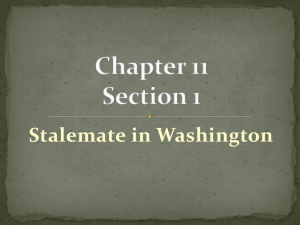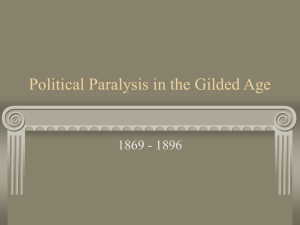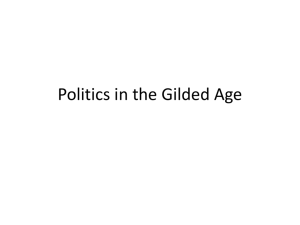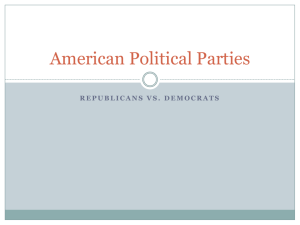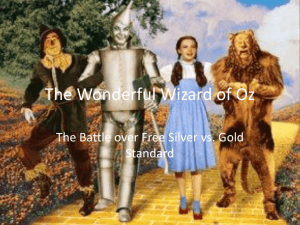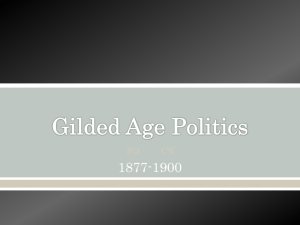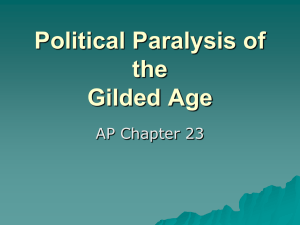POLITICS IN THE GILDED AGE: 1869-1889
advertisement
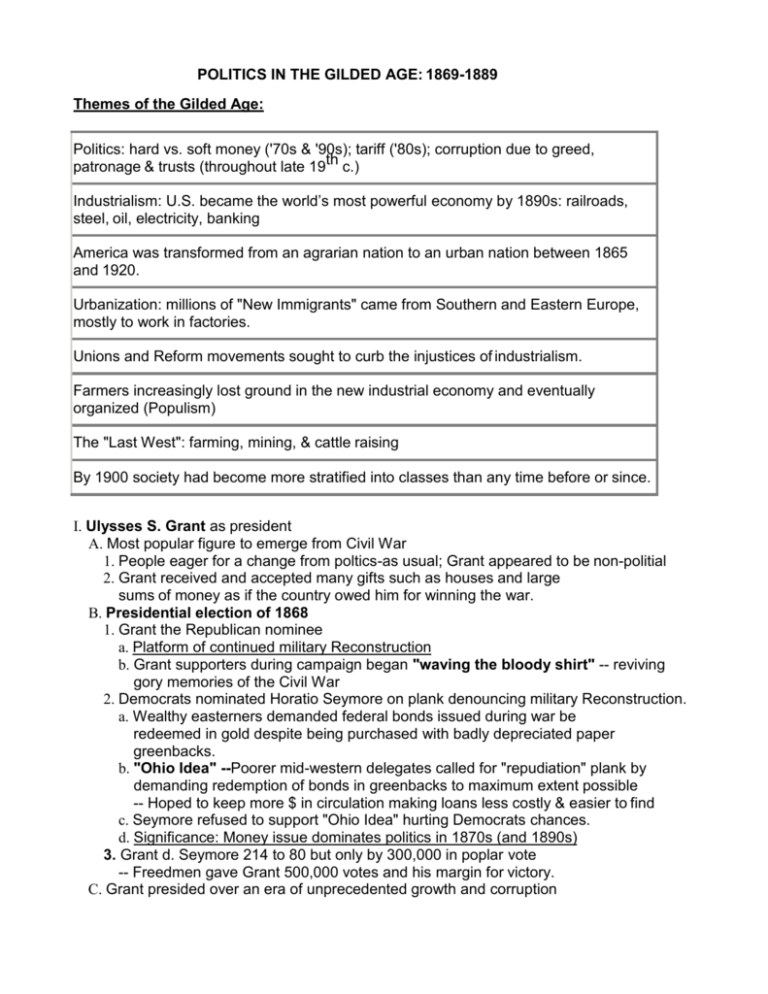
POLITICS IN THE GILDED AGE: 1869-1889
Themes of the Gilded Age:
Politics: hard vs. soft money ('70s & '90s); tariff ('80s); corruption due to greed,
patronage & trusts (throughout late 19th c.)
Industrialism: U.S. became the world’s most powerful economy by 1890s: railroads,
steel, oil, electricity, banking
America was transformed from an agrarian nation to an urban nation between 1865
and 1920.
Urbanization: millions of "New Immigrants" came from Southern and Eastern Europe,
mostly to work in factories.
Unions and Reform movements sought to curb the injustices of industrialism.
Farmers increasingly lost ground in the new industrial economy and eventually
organized (Populism)
The "Last West": farming, mining, & cattle raising
By 1900 society had become more stratified into classes than any time before or since.
I. Ulysses S. Grant as president
A. Most popular figure to emerge from Civil War
1. People eager for a change from poltics-as usual; Grant appeared to be non-politial
2. Grant received and accepted many gifts such as houses and large
sums of money as if the country owed him for winning the war.
B. Presidential election of 1868
1. Grant the Republican nominee
a. Platform of continued military Reconstruction
b. Grant supporters during campaign began "waving the bloody shirt" -- reviving
gory memories of the Civil War
2. Democrats nominated Horatio Seymore on plank denouncing military Reconstruction.
a. Wealthy easterners demanded federal bonds issued during war be
redeemed in gold despite being purchased with badly depreciated paper
greenbacks.
b. "Ohio Idea" --Poorer mid-western delegates called for "repudiation" plank by
demanding redemption of bonds in greenbacks to maximum extent possible
-- Hoped to keep more $ in circulation making loans less costly & easier to find
c. Seymore refused to support "Ohio Idea" hurting Democrats chances.
d. Significance: Money issue dominates politics in 1870s (and 1890s)
3. Grant d. Seymore 214 to 80 but only by 300,000 in poplar vote
-- Freedmen gave Grant 500,000 votes and his margin for victory.
C. Grant presided over an era of unprecedented growth and corruption
1. Grant considered one of worst presidents in U.S. history with much corruption in his
administration and his reluctance to try to end graft in other areas.
2. "Jubilee Jim" Fiske and Jay Gould attempted to corner gold market in 1869
a. Persuaded Grant to make the federal Treasury refrain from selling gold.
b. Fiske and Gould then bid price of gold upward.
c. Treasury finally released gold and the bubble burst ("Panic of 1869")
-- Like the Crash of 1929 with overspeclulation and inflated stock values.
d. Congressional probe found Grant did nothing illegal but acted recklessly.
3. Tweed Ring in NYC (William Marcy Tweed -- 1823-1878)
a. Boss Tweed used bribery, graft, and fraudulent elections to gain perhaps $200 at
the expense of NYC – headed notorious Tammany Hall political machine.
b. NY Times exposed him in 1871
i. Cartoonist Thomas Nast offered $100K bribe to "study art in Paris" so not
to portray Tweed badly; Nast refused despite even higher $ offers.
ii. Samuel Tilden prosecuted Tweed & he was sent to jail where he died
-- Paved way for Tilden’s presidential nomination in 1876
4. Credit Mobilier scandal
a. Railroad construction company formed by insiders of Union Pacific Railway
b. Hired themselves to build the railroad and paid themselves huge fees.
i. Paid dividends of 348% in one year
ii. Distributed shares of stock to congressmen to avoid interference.
c. NY newspaper exposed scandal in 1872 and charges confirmed by
subsequent Congressional investigation that censured 2 members & v.p.
-- Grant’s reputation tarnished although most corruption before his presidency.
5. Whiskey Ring
a. 1875, public discovered Whisky Ring had robbed millions in excise-tax revenues.
-- Grant: "Let no man escape"
b. Yet, one of Grant’s own cabinet members part of the scam.
c. Grant persuaded the jury not to convict.
6. Secretary of War Belknap pocketed $24,000 for selling the privilege of disbursing
supplies to Indians; supplies often worthless.
a. House voted to impeach him and he resigned the same day.
b. Grant accepted resignation "with great regret."
D. Secretary of State Hamilton Fish (one of few bright spots in Grant’s cabinet)
1. Reorganized State Department and adhered to the merit system in civil service.
2. Treaty of Washington (1871): Britain agreed to pay U.S. $15.5 million for
Alabama claims during Civil War.
3. Averted war with Spain by persuading Grant to remain neutral in Cuba’s
struggle for independence.
E. 15th Amendment only major significant accomplishment of Grant administration
-- Grant much more sympathetic to Radical Republicans than Johnson and the Democrats.
F. Election of 1872 (Liberal Republican revolt)
1. Liberal Republican party formed in response to Grant’s corrupt presidency.
a. Slogan: "Turn the rascals out"
b. Horace Greeley nominated for president. (1811-1872)
c. Supported by Carl Schurz, a German immigrant in the 40s who was
an abolitionist and in favor of honesty in gov’t.
2. Democratic party endorsed Greeley who had earlier bashed them as he seemed
to be the strongest candidate available; no Democrats willing to run against Grant
3. Grant d. Greeley 286-66 and by almost 800,000 popular votes.
4. Liberal Republican influence forced the Republican party to reform itself.
a. All but 500 ex-Confederates pardoned in 1872 by a general amnesty act.
b. Reduced high Civil War tariffs.
II. Panic of 1873 and the subsequent depression (1873-1879)
A.Causes
1. Overproduction of railroads, mines, factories and farm products.
2. Bankers made too many risky loans to finance growth.
a. Many loans went unpaid and the banking system collapsed (e.g. Jay Cooke)
b. 15,000 businesses went bankrupt.
3. Depreciation of Greenbacks resulted in hard-money advocates seeking
to increase dollar’s value.
a. Treasury withdrew $100 million decreasing money available to $350 million
b. Hard-money advocates pleased; soft-money advocates dismayed.
B. Greenback Issue
1. Contraction
a. 1874, to stimulate economic growth Congressional Democrats sought inflation
by printing more Greenbacks into circulation.
b. Grant persuaded by hard money folks to veto bill to print more paper $.
-- Conservatives feared uncontrolled growth of money supply and inflation.
c. Specie Resumption Act of 1875: Further withdrawal of Greenbacks
and redemption of all paper currency in gold (not silver) at face value in 1879.
d. Deflation resulted due to less money in circulation.
i. Worsened impact of depression
ii. Yet, boosted nation’s credit rating; brought Greenbacks up to full face value.
C. Debtors push for silver
1.Debtors sought to cause inflation which would increase money supply, making it
easier to pay debts.
2. Treasury in early 1870s claimed silver was only 1/16 value of gold although silver
although prices were higher in the market.
3. Silver producers stopped offering silver for sale to federal mints and Congress
stopped coinage of silver dollars in 1873 – U.S. now off bimetal standard.
4. Silver values hurt further by new mines in West that drove downward silver prices.
5. Westerners cried that the downward trend in silver prices was the "crime of 1873"
a. Silver mining states demanded return to earlier silver prices in order to boost inflation.
b. Republicans refused and Grant maintained hard-money policy.
6. Bland-Allison Act of 1878
a. Compromise where gov’t would buy and coin between $2-4 million per month.
b. Yet, gov’t stuck to legal minimum and inflation did not occur.
-- Although economy grew, currency in circulation didn't keep pace
resulting in lower prices.
D.1878, Greenback Labor Party formed (seeking soft-money) and elected 14 members
to Congress while polling over a million votes.
-- After depression ended in 1879, the currency issue did not come back to center stage
until 1890s.
III. Politics in the Gilded Age
-- Term coined sarcastically by Mark Twain & Charles Dudley Warner in
The Gilded Age (1873)
A.Era of the "forgettable presidents": Hayes, Garfield, Arthur, and Harrison;
Cleveland the only exception – did little of enduring value to the nation
B. Era was most highly competitive politically in U.S. history
1. All presidential elections close and House of Reps switched 6 times
between 1869 and 1891.
-- Voter turnout reached highest levels in U.S. history before and after.
2. Politicians extremely cautious not to tip balance to other party.
3. Yet, few significant economic issues separated the major parties (only money & tariff)
-- Republicans differed only in that they were more successful.
C. Social issues more pronounced in party differences
1. Republicans traced their lineage to Puritanism and stressed strict codes
of personal morality and govt’s involvement in regulating both economic
and moral affairs of the community as a whole—middle class WASP values.
a. Heavy support from businessmen
b. Support from the Midwest and small and rural towns in NE
c. Heavy support from African Americans
d. Emphasized identify-of-interest argument: people should accept their place in
society because the wealthy know what’s best for the country
e. GAR (Grand Army of the Republic), a politically potent fraternal
organization of several hundred thousand Union vets in the Civil War.
2. Democrats consisted of many immigrant Lutherans and Catholics (esp. Irish)
a. Religions stressed less stern views of human weaknesses
b. Views opposed gov’t efforts to impose single moral standard on whole society.
c. Support came from the Solid South and large industrial cities where
immigrants factored in significantly under political machines.
d. Emphasized economic equity
3. Prohibition and education became intense issues at the local level.
D. Patronage and bribery dominated politics
1. Def: Giving away many gov’t offices for votes, kickbacks, and party service.
2. Gov’t employment expanded significantly (e.g. postal service)
3. Reformers targeted the spoils system as being inefficient and a breeding corruption.
-- Civil service reform largely anti-Irish in politics.
E. Republican factions
1. "Stalwarts" headed by Roscoe Conkling, U.S. Senator who favored spoils system
2. "Half-Breeds" led by James G. Blaine, Congressman who favored civil service reform
3. "Mugwumps" -- represented in thought by Thomas Nast
a. Composed of young liberal reformers
b. Favored Reconstruction policies to help African Americans
c. Anti-corruption (continued Liberal Republican ideas)
4. Infighting 1870s and 80s resulted in a dead-locking of the party.
IV. Election of 1876
A. Supporters urged Grant to run for a third term in 1876; Grant was willing
-- House passed a resolution (233-18) to remind the country of two-term tradition.
B. Republicans nominated Rutherford B. Hayes as a compromise candidate
C. Democrats nominated Samuel Tilden (of Boss Tweed fame)
D. Election results
1. Tilden one of only two candidates to win majority of popular votes but lose election.
2. Election fraud in SC, FL, and LA resulted in commission created to determine election.
E. Compromise of 1877
1. Hayes would become president in return for withdrawing remaining federal troops
from last two states, LA and SC.
2. Republicans assured Democrats of presidential patronage and support for a
bill subsidizing a southern transcontinental railroad route.
3. Officially ended Reconstruction and blacks sacrificed in the South.
V. Election of 1880, Garfield and Arthur
A.Republican James Garfield d. Democrat Winfield Hancock (both were Civil War officers)
B. Garfield second president to be assassinated (June, 1881) by a office seeker
Charles J. Guiteau; "I am a Stalwart. Arthur is now president of the U.S."
C. Because vice president Arthur was a Stalwart, it seemed as if Stalwarts
(Conklingites) would
get all the good civil service jobs.
D. Garfield seen as a martyr in a corrupt civil service system—spurred public demand
for reform
E. Pendleton Act of 1883
1. Provisions
a. Prohibited hiring office holders based on wealth.
b. Merit system for making appointments
c. Set up Civil Service Commission charged with administering open
competitive examinations to applicants for posts in classified office.
-- Offices not "classified" by the president open to spoils.
d. By 1884, nearly 10% of federal offices "classified"
e. By 1980’s, about 90% were classified.
2. Problem: Federal patronage from powerful office-seekers was significantly reduced
thus forcing politicians to look increasingly to corporations for campaign financing.
VI. Election of 1884
A. James G. Blaine became the Republican nominee
1. Many Republicans believed Blaine was corrupt
2. Some Republicans left for the Democratic party and dubbed Mugwumps
B. Democrats nominated Grover Cleveland, ex-mayor of buffalo & ex-governor of NY
1. Seen by many as a reformer who stood firm against the railroads in NY.
2. Platform included more honesty and efficiency in government.
C. Campaign
1. Republicans publicized Cleveland’s claimed of having an illegitimate child 8-years prior
2. In NY, a Republican clergyman damned the Democrats as the party of "Rum,
Romanism, and Rebellion" -- thus insulting NY’s Irish community
i. Blaine failed to repudiate the statement
ii. Shortened phrase "RRR" stuck and ultimately cost Blaine crucial NY
D. Election results
1. Cleveland won 219-182 and by about 40,000 popular votes.
2. The desertion of Mugwumps and the NY incident sealed Cleveland’s victory.
3. Cleveland also won the Solid South
4. First Democratic president since Buchanan 28-years earlier
VII. Cleveland’s presidency
A.Staunch believer in laissesz faire: gov’t should leave the free market alone.
B. Initially favored cause of Mugwump reformers but eventually caved in to the
Democratic political machine mindset and fired about 2/3 of federal
C. Military pensions
1. By 1880, military pensions for Civil War veterans were being abused through
loopholes that allowed able-bodied veterans to file fraudulent claims.
2. The GAR was a powerful lobby organization that influenced elections.
3. Cleveland courageously veoted several hundred thousand new pensioners.
D. Tariffs became the major issue separating the two parties in the 1880s.
1. Republicans favored a high tariff; Democrats hated it.
-- Republicans (esp. William McKinley) argued that it stimulated American industry and
enriched all Americans (like "trickle down"); labor supported this somewhat.
2. High tariffs since the Civil War created a treasury surplus annually by
1881 amounting to $145 million.
3. Tariffs stifled American foreign trade, 75 to 80% of which was agricultural
a. Pushed costs for farm production higher
b. As producers and consumers, farmers were double victims.
c. Workers’ wages did not increase nearly at the rate tariffs increased prices.
4. Cleveland sought lower tariffs
a. Believed lower tariffs = lower prices for consumers & less protection for monopolies.
b. Would also end embarrassing treasury surplus.
c. In 1887 annual address to Congress, Cleveland spent entire speech
appealing for lower tariffs.
d. The tariff determined the election of 1888.
E. Landmarks during Cleveland’s term (though not necessarily supported by Cleveland)
1. Dawes Act -- designed to control Indians (see "Great West Chapter")
2. Interstate Commerce Act -- designed to curb railroads (see next chapter)
3. Retrieved 81 million acres of public domain in the West -- land that had
been improperly acquired by "cattle barons" or the railroads. (See "Progressivism")
VIII. Election of 1888 – tariff primary issue
A. Democrats grudgingly renominated Cleveland.
B. Republicans nominated Benjamin Harrison (grand-son of William H. Harrison)
C. Harrison d. Cleveland 233-168 (although Cleveland had more popular votes)
1. Only 2nd time in U.S. history person with most popular votes lost election.
2. Cleveland the first sitting president to be voted out since Van Buren in 1840.
3. Republicans interpreted victories in House (1st time in over a decade) and the Senate
as a mandate for the tariff. Tariffs subsequently increased.
Bibliography:
Bailey, Thomas A., Kennedy, David M.: The American Pageant, 10th edition, Lexington,
Massachusetts: D.C. Heath, 1994
College Board, Advanced Placement Course Description: History -- United States, European
History, College Entrance Examination Board, 1996
Foner, Eric & Garraty, John A. editors: The Reader’s Companion to American History, Boston:
Houghton MifflinCompany, 1991
Nash, Gary : American Odyssey, Lake Forest, Illinois: Glencoe, 1992
Painter, Nell Irvin, Standing at Armageddon: The United States, 1877-1919, New York: W.
W. Norton, 1987
Schultz, Constance G., The American History Videodisc Master Guide, Annapolis, Maryland:
Instruction Resources Corporation, 1995
Zinn, Howard, A People’s History of the United States, New York: Harper and Row, 1980
